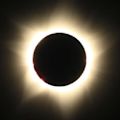Search results
On April 8, 2024, a spectacular and rare celestial event unfolded over Canada, the United States and Mexico – a total solar eclipse. As the Moon aligned perfectly between Earth and the Sun, temporary darkness swept across parts of the country, captivating countless spectators.
By convention, eclipses are named after their darkest phase—if a solar eclipse is total at any point on Earth, it is called a total solar eclipse. Hybrid solar eclipses or annular-total eclipses are an exception to this rule.
Apr 8, 2024 · On April 8, 2024, a total solar eclipse moved across North America, passing over Mexico, the United States, and Canada. A total solar eclipse happens when the Moon passes between the Sun and Earth, completely blocking the face of the Sun. The sky will darken as if it were dawn or dusk.
Apr 8, 2024 · What is a total solar eclipse? A solar eclipse occurs when the moon orients itself between Earth and the sun, shielding the solar surface from our view.
Apr 8, 2024 · Millions of people across North America fell into chilly midday darkness on Monday as a total solar eclipse slid across the continent for the first time in seven years, leaving crowds to...
List of Total Solar Eclipses Worldwide Next 10 Years. Check where the eclipses are visible and if you can see them.
Mar 1, 2024 · Total solar eclipses occur when the moon passes in front of the sun, blocking out its light. The path of that shadow is extremely narrow, which is why most people have likely never seen one.
Apr 9, 2024 · A total solar eclipse, which was experienced Monday by millions of skygazers in parts of Mexico, the United States and Canada, has concluded its path over North America.
Apr 8, 2024 · When will the next total solar eclipse be visible in Canada? The next total solar eclipse to be visible in Canada will occur on August 22, 2044. Partial solar eclipse of March 29, 2025. On March 29, 2025, a partial solar eclipse will be visible in eastern Canada.
The table below is a concise summary of all total, annular and hybrid solar eclipses from 2021 through 2040 (excluding partial eclipses). The links in the table provide additional information and graphics for each eclipse.

